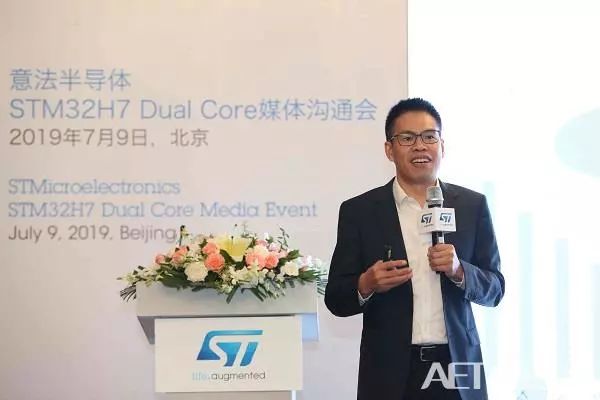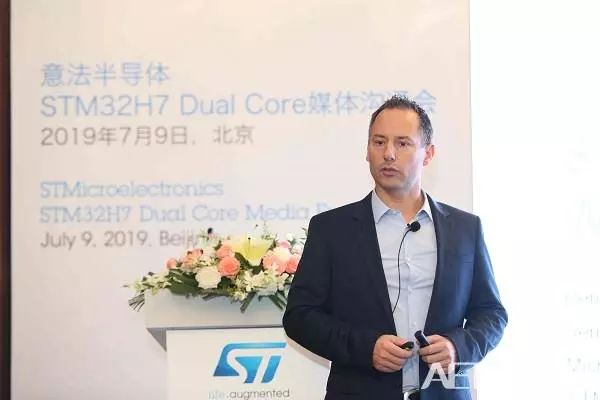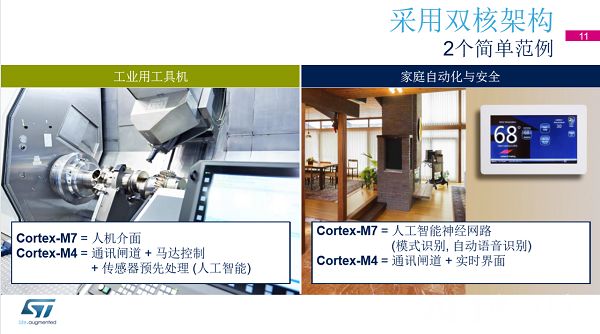In the field of embedded MCUs, CoreMark is a well-known method for measuring MCU performance, and the CoreMark score often becomes an important indicator for evaluating the performance of a certain MCU. Recently, STMicroelectronics launched the new generation STM32H7, which set a record for Cortex-M general-purpose MCUs with a score of 3224 in CoreMark, becoming the undisputed performance king among general-purpose MCUs based on the Cortex-M core.
In STMicroelectronics’ powerful STM32 family, there are multiple product series based on different Cortex-M cores, targeting various application positions, including ultra-low power series, mainstream MCU series, high-performance series, wireless series, and more. Among them, the STM32H7, based on Cortex-M7, released in 2016 has always been the representative of high-performance MCUs in the STM32 family.
The newly launched STM32H7 is a dual-core version of the STM32H7, adding a Cortex-M4 core on top of the original Cortex-M7. This new generation of STM32H7 not only pushes the performance of Cortex-M general-purpose MCUs to a new peak but also brings great convenience to users with its new designs in security and built-in peripherals, making it a perfect combination of strong performance and rich functionality.
Robust Growth of STM32 Processors
Mr. Cao Jindong, Director of Marketing and Applications for Microcontrollers at STMicroelectronics China, introduced the overall business development situation of ST in the MCU field. He stated that globally, STMicroelectronics’ performance in the MCU sector improved in 2018 compared to 2017, moving from third place in the global market in 2017 to second place in 2018. In the Chinese market, STMicroelectronics ranked first in the Chinese MCU market in 2018.

Mr. Cao Jindong, Director of Marketing and Applications for Microcontrollers at STMicroelectronics China
Mr. Cao indicated that STMicroelectronics has maintained continuous growth in the MCU field for over a decade, and this growth is “organic”—completely driven by its own business development rather than through acquisitions, mergers, or other means.
Mr. Cao attributed STMicroelectronics’ success in the Chinese market to three development strategies that ST has actively pursued from the past to the present and into the future: first, actively expanding the ecosystem and partnerships; second, focusing on vertical applications; and third, providing broader support for small and medium-sized customers. Mr. Cao stated, “This matrix ensures that our business can develop healthily and sustainably in the long term, which is a complementary result.”
Regarding the future planning of STM32, Mr. Cao mentioned that on one hand, in terms of products, STMicroelectronics will launch more targeted product lines based on application needs, such as higher performance, lower power consumption, wireless connectivity, and more cost-competitive solutions; on the other hand, there will be a stronger software ecosystem development, including development platforms, artificial intelligence, graphic design, security services, and more.
Dual-Core Creates the King of MCU Performance
Renaud BOUZEREAU, Senior Marketing Manager of the STM32 High-Performance Product Line at STMicroelectronics, provided a detailed introduction to the newly launched STM32H7.

Renaud BOUZEREAU, Senior Marketing Manager of the STM32 High-Performance Product Line at STMicroelectronics
The STM32H7 dual-core product includes two cores: one is a Cortex-M7 with a main frequency of 480 MHz, equipped with a double-precision floating-point unit, MPU, DSP, and level 1 cache; the other core is a Cortex-M4 with a main frequency of 240 MHz, equipped with a single-precision FPU, DSP, MPU, and ST’s unique ART accelerator. The dual-core architecture gives the newly launched STM32H7 a powerful performance, achieving a CoreMark score of over 3200.
Renaud BOUZEREAU stated that the powerful core of the STM32H7 is supported by a robust architecture, mainly including four aspects:
(1) In the display section, because the STM32H7 includes a Chrom-ART accelerator and MJPEG encoder, it can reduce the workload by 90% during image display.
(2) In terms of data transfer, the main DMA embedded in the STM32H7 series can trigger event links and handle the most complex data transfer configurations between memory and peripherals, providing up to 16 channels, thereby reducing the CPU’s workload.
(3) The STM32H7 embeds a high-precision timer module that can generate complex PWM outputs, including all event types. This high-precision process is mainly aimed at digital power supplies or more complex event triggers, where the CPU does not need to participate in many event-triggering processes under set trigger modes.
(4) In data encryption and decryption, it includes hardware encryption algorithms, including a hardware accelerator for hashing, allowing customers to switch from software-based encryption to using internal hardware resources for encryption and decryption, which can also reduce the CPU workload by 90%.
What application scenarios are primarily suited for the dual-core design? Renaud BOUZEREAU presented two examples: the first is the human-machine interface in industrial control, where the dual-core allows customers to freely assign tasks to the two cores for different tasks, such as processing the human-machine interface display control on the Cortex-M7 and real-time control tasks, such as gateway communication, motor drive, and sensor data acquisition on the real-time processing core, Cortex-M4. The second example is in home automation and security modules, where the Cortex-M7 can handle artificial intelligence neural networks, including applications such as image display, voice recognition, and image recognition; the Cortex-M4 core handles real-time tasks, such as Wi-Fi communication and Ethernet real-time communication modules.

Regarding the advantages of the dual-core architecture, Renaud BOUZEREAU summarized four main aspects: increased system performance, increased system efficiency, shortened development cycles, and reduced system costs.
First, the two cores can operate independently, allowing for two different tasks or executing one task while monitoring the other core’s application to ensure its safety. In this architecture, computation time and average power consumption in applications can be reduced.
In terms of power architecture, the STM32H7 dual-core products are divided into three power domains: the high-performance domain, where the Cortex-M7 handles GUI, DSP, and security control; the second domain, Cortex-M4, primarily handles real-time connectivity and control tasks, such as external connections, real-time operating systems, motor drives, and more control tasks. The third domain is called the high-data-collection domain, where the other two domains remain in sleep mode while this domain automatically collects data from sensors, including external voltage and current. Once a certain quantity or threshold is reached, it can wake the other two domains for processing. In the three domains, work timing can be freely allocated, allowing for dynamic power consumption balance.
Because the two cores of the STM32H7 work independently, tasks can be directly assigned to the dual-core for processing. Therefore, during development, the configurations, including internal resources, can be allocated so that the two teams can develop based on their own cores or allocated resources, without affecting the work of the other team, thereby shortening the circuit board design and project evaluation time.
Fourth, dual-core products can reduce the overall system cost. Because many peripheral resources are built into the STM32H7 dual-core products, in many cases, there is no need for additional external components such as ADCs, comparators, and amplifiers, thereby reducing the demand for external devices. The dual-core nature allows the functions completed by two systems to be integrated into one system, which can be handled by the dual-core MCU.


